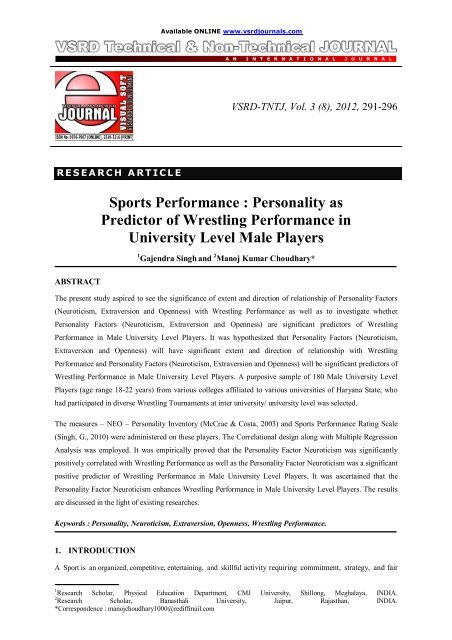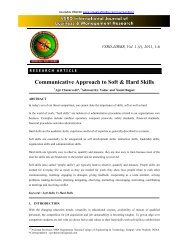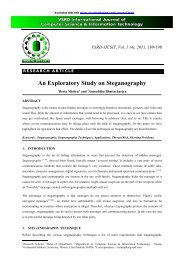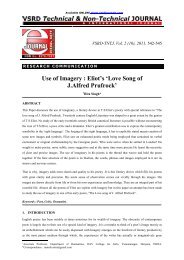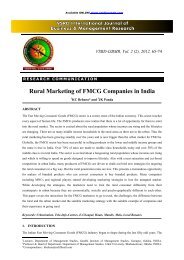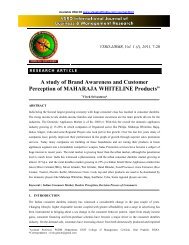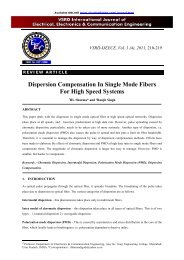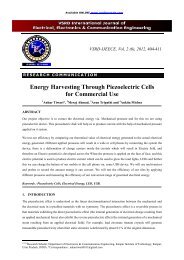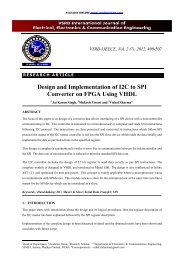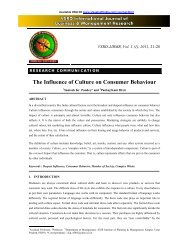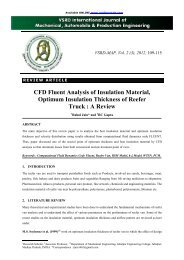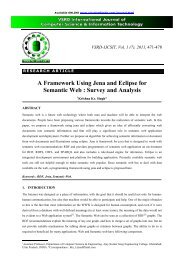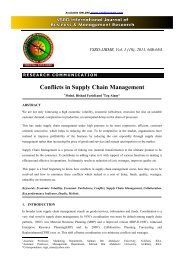Sports Performance : Personality as Predictor of Wrestling ...
Sports Performance : Personality as Predictor of Wrestling ...
Sports Performance : Personality as Predictor of Wrestling ...
Create successful ePaper yourself
Turn your PDF publications into a flip-book with our unique Google optimized e-Paper software.
R E S E A R C H A R T II C L E<br />
ABSTRACT<br />
____________________________<br />
Available ONLINE www.vsrdjournals.com<br />
VSRD-TNTJ, Vol. 3 (8), 2012, 291-296<br />
<strong>Sports</strong> <strong>Performance</strong> : <strong>Personality</strong> <strong>as</strong><br />
<strong>Predictor</strong> <strong>of</strong> <strong>Wrestling</strong> <strong>Performance</strong> in<br />
University Level Male Players<br />
1 Gajendra Singh and 2 Manoj Kumar Choudhary*<br />
The present study <strong>as</strong>pired to see the significance <strong>of</strong> extent and direction <strong>of</strong> relationship <strong>of</strong> <strong>Personality</strong> Factors<br />
(Neuroticism, Extraversion and Openness) with <strong>Wrestling</strong> <strong>Performance</strong> <strong>as</strong> well <strong>as</strong> to investigate whether<br />
<strong>Personality</strong> Factors (Neuroticism, Extraversion and Openness) are significant predictors <strong>of</strong> <strong>Wrestling</strong><br />
<strong>Performance</strong> in Male University Level Players. It w<strong>as</strong> hypothesized that <strong>Personality</strong> Factors (Neuroticism,<br />
Extraversion and Openness) will have significant extent and direction <strong>of</strong> relationship with <strong>Wrestling</strong><br />
<strong>Performance</strong> and <strong>Personality</strong> Factors (Neuroticism, Extraversion and Openness) will be significant predictors <strong>of</strong><br />
<strong>Wrestling</strong> <strong>Performance</strong> in Male University Level Players. A purposive sample <strong>of</strong> 180 Male University Level<br />
Players (age range 18-22 years) from various colleges affiliated to various universities <strong>of</strong> Haryana State, who<br />
had participated in diverse <strong>Wrestling</strong> Tournaments at inter university/ university level w<strong>as</strong> selected.<br />
The me<strong>as</strong>ures – NEO – <strong>Personality</strong> Inventory (McCrae & Costa, 2003) and <strong>Sports</strong> <strong>Performance</strong> Rating Scale<br />
(Singh, G., 2010) were administered on these players. The Correlational design along with Multiple Regression<br />
Analysis w<strong>as</strong> employed. It w<strong>as</strong> empirically proved that the <strong>Personality</strong> Factor Neuroticism w<strong>as</strong> significantly<br />
positively correlated with <strong>Wrestling</strong> <strong>Performance</strong> <strong>as</strong> well <strong>as</strong> the <strong>Personality</strong> Factor Neuroticism w<strong>as</strong> a significant<br />
positive predictor <strong>of</strong> <strong>Wrestling</strong> <strong>Performance</strong> in Male University Level Players. It w<strong>as</strong> <strong>as</strong>certained that the<br />
<strong>Personality</strong> Factor Neuroticism enhances <strong>Wrestling</strong> <strong>Performance</strong> in Male University Level Players. The results<br />
are discussed in the light <strong>of</strong> existing researches.<br />
Keywords : <strong>Personality</strong>, Neuroticism, Extraversion, Openness, <strong>Wrestling</strong> <strong>Performance</strong>.<br />
1. INTRODUCTION<br />
A Sport is an organized, competitive, entertaining, and skillful activity requiring commitment, strategy, and fair<br />
1 Research Scholar, Physical Education Department, CMJ University, Shillong, Meghalaya, INDIA.<br />
2 Research Scholar, Ban<strong>as</strong>thali University, Jaipur, Raj<strong>as</strong>than, INDIA.<br />
*Correspondence : manojchoudhary1000@rediffmail.com
Manoj Kr. Choudhary et al / VSRD Technical & Non-Technical Journal Vol. 3 (8), 2012<br />
play, in which a winner can be defined by objective means. Activities such <strong>as</strong> board games and card games are<br />
sometimes cl<strong>as</strong>sified <strong>as</strong> "mind sports," but strictly speaking "sport" by itself refers to some physical activity.<br />
Non-competitive activities may also qualify, for example though jogging or playing catch are usually cl<strong>as</strong>sified<br />
<strong>as</strong> forms <strong>of</strong> recreation, they may also be informally called "sports" due to their similarity to competitive games.<br />
<strong>Sports</strong> are governed by a set <strong>of</strong> rules or customs (Dreschler, B., Jones, J. W., et. al., 2007).<br />
<strong>Personality</strong> can have a pr<strong>of</strong>ound effect on the positive or negative experience <strong>of</strong> sports for sportspersons. Such<br />
effects can either help or hinder the player, depending on the emotion that the player chooses to express and the<br />
situation in which he or she choose to express that emotion. Sport and physical activity programs can provide an<br />
effective vehicle for youth to develop at a personal, social and emotional level. Such personality traits <strong>as</strong><br />
perfectionism, anger, and over-competitiveness, however, also have the potential <strong>of</strong> influencing a young player's<br />
sense <strong>of</strong> self-concept (Apter, M.J., 1984). Conventional sport culture suggests that youth sport effectively<br />
promotes personality development and "builds character". As youth sport participation h<strong>as</strong> risen in recent years,<br />
sport psychological literature h<strong>as</strong> <strong>as</strong> well. However, few empirical sources specifically address personality<br />
development and youth sports involvement (Cooper L, 1969). Because the sport culture continues to change and<br />
higher demands are placed upon youth in terms <strong>of</strong> performance, the general media h<strong>as</strong> latched on to several <strong>of</strong><br />
these concepts, but <strong>of</strong>ten do not have empirical data to support their claims.<br />
Blanco, Hill, and Piedmont (1999) found that the five-factor model <strong>of</strong> personality could be used to make<br />
predictions about the player’s performance in sports. The five-factor model <strong>of</strong> personality is a very useful tool in<br />
<strong>as</strong>sessing individual differences. The five-factor model, also known <strong>as</strong> "the big five" <strong>of</strong> personality, includes<br />
five dimensions <strong>of</strong> personality. They are extraversion, neuroticism, conscientiousness, agreeableness, and<br />
openness to experience. These dimensions <strong>of</strong> personality are <strong>as</strong>sociated with different <strong>as</strong>pects <strong>of</strong> an individual's<br />
personality traits such <strong>as</strong> being <strong>as</strong>sertive, emotional stability, and a person's tendency to experience distress. The<br />
first <strong>of</strong> the big five, extraversion, deals with an individual’s tendency toward being either extraverted or<br />
introverted and, therefore, whether a person is talkative, <strong>as</strong>sertive, sociable, or not. The second dimension,<br />
neuroticism, reveals an individuals' emotional stability and their tendency to experience distress and to be able<br />
to effectively handle, emotionally, any such stressful situation. Anxiety, depression and worry are <strong>of</strong>ten<br />
<strong>as</strong>sociated with this dimension <strong>of</strong> personality. Extraversion and neuroticism are <strong>of</strong>ten referred to <strong>as</strong> the "big<br />
two." Third is conscientiousness, which deals with an individual's will to achieve goals and their dependability.<br />
This dimension can also be used to describe a person <strong>as</strong> careful, responsible and thorough.<br />
The fourth <strong>of</strong> the big five is agreeableness. It describes a person's humanity, or, in other words, their emotional<br />
support or hostility, caring, and nurturance or a lack there <strong>of</strong>. Behaviorally, the fourth factor describes a person<br />
<strong>as</strong> being good-natured, courteous, s<strong>of</strong>t-hearted, tolerant, or not. The l<strong>as</strong>t <strong>of</strong> the big five is openness, or, more<br />
specifically, openness to experiences. This is related to an individual's creativity and divergent thinking. It also<br />
describes whether or not a person is open to new feelings and ide<strong>as</strong>, flexible, or willing to use their imagination.<br />
Sport psychologists have conducted significant research in regard to sports performance and the five-factor<br />
model <strong>of</strong> personality. Costa and McCrae's model utilizes five dimensions in order to provide a broader<br />
description <strong>of</strong> personality. These five factors (Neuroticism, Extraversion, Openness, Agreeableness, and<br />
Conscientiousness) were derived empirically, using trait ratings to analyze personality. According to Costa and<br />
292
Manoj Kr. Choudhary et al / VSRD Technical & Non-Technical Journal Vol. 3 (8), 2012<br />
McCrae (1999), these traits are relatively stable over time. Most importantly, the model serves <strong>as</strong> a paradigm to<br />
predict life outcomes. Most <strong>of</strong> the current research on the five-factor model and sports performance use statistics<br />
<strong>as</strong> the sole determinant <strong>of</strong> sports performance. While this strategy does provide some determination <strong>of</strong><br />
performance, it fails to take into account other factors <strong>of</strong> performance, such <strong>as</strong> coach ability or "team playness".<br />
In Piedmont's study, female soccer players were <strong>as</strong>ked to complete bipolar inventory, designed to account for all<br />
five dimensions <strong>of</strong> personality. In addition, the coaches <strong>of</strong> the players were <strong>as</strong>ked to rate their players in terms <strong>of</strong><br />
intangibles (e.g., coach ability). At the conclusion <strong>of</strong> the se<strong>as</strong>on, comparisons were drawn between personality,<br />
on-field performance and the coaches' ratings.<br />
The results display that the dimensions <strong>of</strong> Neuroticism and Conscientiousness were related to sports<br />
performance. There were positive correlations between Conscientiousness, sports performance and positive<br />
coaches' ratings. Previous research suggested that players were typically dominant (i.e. low Agreeableness),<br />
however, the present study encourages a drive for a success, motivational approach. Secondly, this research data<br />
suggests a positive correlation between performance and low Neuroticism. McCrae & Costa maintained that a<br />
low neuroticism score could be related to performing under pressure, tolerating stress and controlling<br />
impulsivity, all positive characteristics <strong>of</strong> a successful player. Third, there w<strong>as</strong> little correlation between low<br />
extroversion (i.e. introversion) and high performance levels. This idea h<strong>as</strong> been studied in the p<strong>as</strong>t. Previous<br />
research suggested that extraversion enabled players to perform well in front <strong>of</strong> audiences (Kane, E., 1964).<br />
2. PROBLEM<br />
“<strong>Sports</strong> <strong>Performance</strong>: <strong>Personality</strong> <strong>as</strong> <strong>Predictor</strong> <strong>of</strong> <strong>Wrestling</strong> <strong>Performance</strong> in University Level Male Players”.<br />
3. OBJECTIVES<br />
The study w<strong>as</strong> conducted with the following objectives :<br />
To investigate the significance <strong>of</strong> extent and direction <strong>of</strong> relationship <strong>of</strong> <strong>Personality</strong> Factors (Neuroticism,<br />
Extraversion and Openness) with <strong>Wrestling</strong> <strong>Performance</strong> in Male University Level Players.<br />
To investigate whether <strong>Personality</strong> Factors (Neuroticism, Extraversion and Openness) are significant<br />
predictors <strong>of</strong> <strong>Wrestling</strong> <strong>Performance</strong> in Male University Level Players.<br />
4. HYPOTHESES<br />
The study intended to test the following hypotheses:<br />
<strong>Personality</strong> Factors (Neuroticism, Extraversion and Openness) will have significant extent and direction <strong>of</strong><br />
relationship with <strong>Wrestling</strong> <strong>Performance</strong> in Male University Level Players.<br />
<strong>Personality</strong> Factors (Neuroticism, Extraversion and Openness) will be significant predictors <strong>of</strong> <strong>Wrestling</strong><br />
<strong>Performance</strong> in Male University Level Players.<br />
293
5. VARIABLES<br />
Manoj Kr. Choudhary et al / VSRD Technical & Non-Technical Journal Vol. 3 (8), 2012<br />
<strong>Personality</strong> Factors (Neuroticism, Extraversion and Openness)<br />
6. METHODOLOGY<br />
6.1 Sample<br />
A purposive sample <strong>of</strong> 180 University Level Male Wrestlers (age range 18-22 years) w<strong>as</strong> selected for the<br />
present study. These Wrestlers were sampled from various colleges affiliated to various universities <strong>of</strong> Haryana<br />
state. Only those Wrestlers were picked up for sampling who had participated in diverse competitive wrestling<br />
tournaments at inter university /university level.<br />
6.2 Me<strong>as</strong>ures<br />
1) NEO-<strong>Personality</strong> Inventory (McCrae & Costa, 2003)<br />
2) <strong>Sports</strong> <strong>Performance</strong> Rating Scale (Nain, G., 2010)<br />
6.3 Statistical Analysis<br />
Descriptive Statistics (Mean and Standard Deviation) <strong>of</strong> all the groups w<strong>as</strong> computed through SPSS-17<br />
s<strong>of</strong>tware.<br />
Pearson Product-moment Correlation w<strong>as</strong> computed to investigate the significance <strong>of</strong> extent and direction <strong>of</strong><br />
relationship <strong>of</strong> <strong>Personality</strong> Factors (Neuroticism, Extraversion and Openness) with <strong>Wrestling</strong> <strong>Performance</strong> in<br />
Male University Level Players.<br />
The Multiple Regression Analysis w<strong>as</strong> also computed to see whether <strong>Personality</strong> Factors (Neuroticism,<br />
Extraversion and Openness) are significant predictors <strong>of</strong> <strong>Wrestling</strong> <strong>Performance</strong> in Male University Level<br />
Players.<br />
Correlation Matrix for <strong>Personality</strong> and <strong>Wrestling</strong> <strong>Performance</strong> in<br />
Neuroticism 1<br />
Male University Level Players (N = 180)<br />
Neuroticism Extraversion Openness <strong>Wrestling</strong> <strong>Performance</strong><br />
Extraversion .033 1<br />
Openness -.024 .289 ** 1<br />
<strong>Wrestling</strong> <strong>Performance</strong> .677 ** .008 .054 1<br />
**Significant at 0.01 level<br />
294
Manoj Kr. Choudhary et al / VSRD Technical & Non-Technical Journal Vol. 3 (8), 2012<br />
Coefficients <strong>of</strong> the Regression Model: <strong>Personality</strong> and <strong>Wrestling</strong> <strong>Performance</strong><br />
in Male University Level Players<br />
Model Summary<br />
Model R<br />
R<br />
Square<br />
Adjusted R<br />
Square<br />
Std. Error <strong>of</strong><br />
the Estimate<br />
R Square<br />
Change<br />
Change Statistics<br />
F<br />
f1 f2<br />
Change<br />
Sig. F<br />
Change<br />
1 .681 a .464 .455 .970 .464 50.847 3 176 .000<br />
a. <strong>Predictor</strong>s: (Constant), N, E, O<br />
1<br />
1<br />
7. RESULTS<br />
ANOVA b<br />
Model Sum <strong>of</strong> Squares df Mean Square F Sig.<br />
Regression 143.519 3 47.840 50.847 .000 a<br />
Residual 165.592 176 .941<br />
Total 309.111 179<br />
Coefficients a<br />
a. <strong>Predictor</strong>s: (Constant), N, E, O<br />
b. Dependent Variable: WP<br />
Model<br />
Unstandardized Coefficients Standardized Coefficients<br />
T Sig.<br />
B Std. Error Beta<br />
(Constant) -.671 .815<br />
-.823 .412<br />
N .111 .009 .680 12.311 .000 **<br />
E -.012 .018 -.038 -.652 .515<br />
O .025 .018 .081 1.410 .160<br />
a. Dependent Variable: WP<br />
** Significant at 0.01 level<br />
The Pearson Product-moment Correlation w<strong>as</strong> computed to investigate the significance <strong>of</strong> extent and direction<br />
<strong>of</strong> relationship <strong>of</strong> <strong>Personality</strong> Factors (Neuroticism, Extraversion and Openness) with <strong>Wrestling</strong> <strong>Performance</strong> in<br />
Male University Level Players. It w<strong>as</strong> empirically proved that <strong>Wrestling</strong> <strong>Performance</strong> w<strong>as</strong> significantly<br />
positively correlated with Neuroticism (r = .677; p=0.01). Thus the hypothesis no 1 (Ho 1) that <strong>Personality</strong><br />
Factors (Neuroticism, Extraversion and Openness) will have significant extent and direction <strong>of</strong> relationship with<br />
<strong>Wrestling</strong> <strong>Performance</strong> in Male University Level Players stands partially accepted at 0.01 level <strong>of</strong> confidence<br />
specifically with respect to <strong>Personality</strong> Factor Neuroticism and any rival /alternative hypothesis is not tenable.<br />
The Multiple Regression Analysis w<strong>as</strong> computed to investigate whether <strong>Personality</strong> Factors (Neuroticism,<br />
Extraversion and Openness) are significant predictors <strong>of</strong> <strong>Wrestling</strong> <strong>Performance</strong> in Male University Level<br />
Players. It w<strong>as</strong> again empirically proved that Neuroticism w<strong>as</strong> a significant positive predictor <strong>of</strong> <strong>Wrestling</strong><br />
<strong>Performance</strong>. Thus the hypothesis no. 2 [Ho 2] that <strong>Personality</strong> Factors (Neuroticism, Extraversion and<br />
Openness) will be significant predictors <strong>of</strong> <strong>Wrestling</strong> <strong>Performance</strong> in Male University Level Players stands<br />
partially accepted at 0.01 level <strong>of</strong> confidence specifically with respect to <strong>Personality</strong> Factor Neuroticism and any<br />
rival/alternative hypothesis is not tenable. The aforesaid results are <strong>as</strong> per theoretical expectations and can be<br />
vindicated by the following empirical researches (Piedmont, R. L., Hill, D. C., & Blanco, S. (1999);Erdheim, J.,<br />
& Wang, M. (2007)).<br />
295
Manoj Kr. Choudhary et al / VSRD Technical & Non-Technical Journal Vol. 3 (8), 2012<br />
8. REFERENCES<br />
[1] Altmann, R., Dreschler, B., Jones, J. W., & Neuman, G. (2007). Development <strong>of</strong> the sports performance<br />
inventory: A psychological me<strong>as</strong>ure <strong>of</strong> athletic potential. Journal <strong>of</strong> Business and Psychology, 15(3), 491-<br />
503.<br />
[2] Apter, M.J. (1984). Reversal theory and personality: A review. Journal <strong>of</strong> Research in <strong>Personality</strong>, 18, 265-<br />
288.<br />
[3] Cooper L, (1969). Athletics, activity and personality: a review <strong>of</strong> the literature. Res Q; 40: 17-22.<br />
[4] Erdheim, J., & Wang, M. (2007). Does the five-factor model <strong>of</strong> personality relate to goal orientation?<br />
<strong>Personality</strong> and Individual Differences, 43(6), 1493-1505.<br />
[5] Kane, E. (1964). Psychological correlates <strong>of</strong> physique and physical abilities. International Research in<br />
<strong>Sports</strong> and Education, 85-94.<br />
[6] Morgan, W.P., O'Connor, P.J., Ellickson, K.A., & Bradley, P.W. (1988). <strong>Personality</strong> structure, mood states,<br />
and performance in elite male distance runners. International Journal <strong>of</strong> Sport Psychology, 19, 247-263.<br />
[7] Piedmont, R. L., Hill, D. C., & Blanco, S. (1999). Predicting athletic performance using the five-factor<br />
model <strong>of</strong> personality. <strong>Personality</strong> and Individual Differences, 27(4) 769-777.<br />
[8] Costa, P., & McCrae, R. (1999). Influence <strong>of</strong> extraversion and neuroticism on subjective well-being: Happy<br />
and unhappy people. Journal <strong>of</strong> <strong>Personality</strong> and Social Psychology, 38, 668-678.<br />
<br />
296


